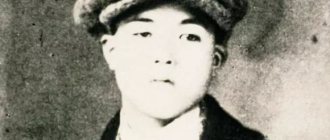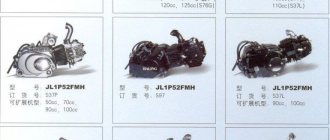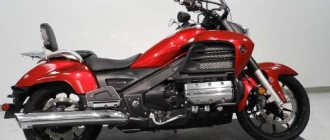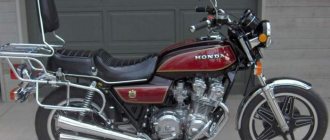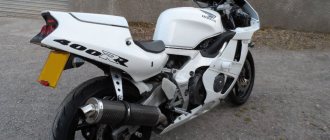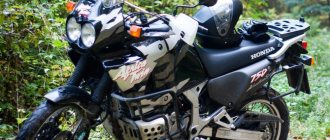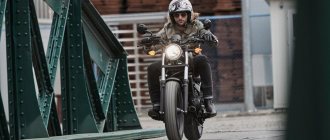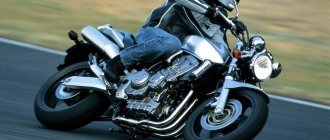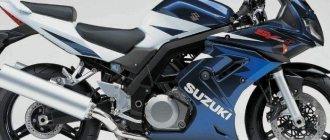CBR 1000RR
- Honda motorcycle model
The Honda CBR1000RR Fireblade sports motorcycle model appeared on the market in 2004, replacing the Honda CBR954RR Fireblade. Unlike the previous version, the new model received a number of technical differences and features of the RC211V racing prototype - a new frame, suspension and engine, a new braking system with radial calipers, an electronic steering damper (Honda Electronic Steering Damper - HESD), an injector with dual throttle valves (Dual Stage Fuel Injection - DSFI), etc.
In 2006, the Honda CBR1000RR Fireblade was restyled, receiving a slightly updated appearance, a modified engine (different cylinder head ports, larger intake valves, increased compression ratio, modified valve timing), a new exhaust, new chassis geometry, different rear suspension settings and increased brakes. discs at the front.
In 2008, the model undergoes major changes that affected the appearance and technical part - a new engine, new control unit settings, an updated inertial charging system (Ram-Air), a new exhaust, a slipper clutch with an assistant, a new lightweight frame.
2009 was marked by the appearance of versions with a combined braking system + ABS (such modifications were designated CBR1000RA).
At the end of 2011, Honda updated the Fireblade again, offering a new design of the motorcycle, a new Big Piston front fork, new wheels and a new generation of software for the combined brake system.
In 2014, in addition to the basic version of the motorcycle, Honda released a “racing” modification to the market - the Honda CBR1000RR SP. It features original colors, minor changes to the engine, Ohlins suspension, Brembo monoblock brake calipers and combined ABS as stock.
In 2021, another update of the Honda CBR1000RR Fireblade was released. The model received a new design, a new engine version, an electronic throttle, the ability to select engine operating modes (Honda Selectable Torque Control - HSTC) and a fuel tank reduced to 16 liters. The Honda CBR1000RR SP has also been updated with Ohlins Smart EC electronic suspension, a titanium fuel tank, a lighter lithium-ion battery and a quick shifter as standard.
The following models were created based on the Honda CBR1000RR Fireblade engine:
Honda CBF 1000
Honda CB1000R
Model history
2004 - start of production and sales. First generation. Model: Honda CBR1000RR Fireblade (all markets). Frame number: SC28~. Model code: CBR1000RR4.
2005 - no significant changes. Model: Honda CBR1000RR Fireblade (all markets). Frame number: SC28~. Model code: CBR1000RR5.
2006 - restyling of the model. Second generation. The design of the front plastic has been slightly changed, a new modified engine, a new exhaust system, new chassis geometry, the diameter of the front brake discs has increased (310 → 320 mm). Model: Honda CBR1000RR Fireblade (all markets). Frame number: SC28~. Model code: CBR1000RR6.
2007 - no significant changes. Model: Honda CBR1000RR Fireblade (all markets). Frame number: SC28~. Model code: CBR1000RR7.
2008 - restyling of the model. Third generation. New engine with titanium valves, lined pistons and increased compression ratio. New ECU control unit settings. The model is equipped with a slipper clutch with an assistant. Additional work to lighten the motorcycle. Model: Honda CBR1000RR Fireblade (all markets). Frame number: SC28~. Model code: CBR1000RR8.
2009 - appearance of a modification with combined ABS. Model: Honda CBR1000RR Fireblade + ABS (all markets). Model code: CBR1000RR9 + CBR1000RA9.
2010 - no significant changes. Model: Honda CBR1000RR Fireblade + ABS (all markets). Model code: CBR1000RRA + CBR1000RAA.
November 2011 - restyling of the model. Fourth generation. These models are the same as the 2012 versions. New appearance, new 12-spoke wheels, new front fork - Showa Big Piston, new ABS software. Model: Honda CBR1000RR Fireblade + ABS (all markets). Model code: CBR1000RRB + CBR1000RAB.
2012 - no significant changes. Model: Honda CBR1000RR Fireblade + ABS (all markets). Model code: CBR1000RRC + CBR1000RAC.
2013 - no significant changes. Model: Honda CBR1000RR Fireblade + ABS (all markets). Model code: CBR1000RRD + CBR1000RAD.
2014 - the appearance of a “racing” modification - Honda CBR1000RR SP Fireblade. Model: Honda CBR1000RR Fireblade + ABS (all markets). Model code: CBR1000RRE + CBR1000RAE.
2015 - no significant changes. Model: Honda CBR1000RR Fireblade + ABS (all markets). Model code: CBR1000RRF + CBR1000RAF.
2016 - no significant changes. Model: Honda CBR1000RR Fireblade + ABS (all markets). Model code: CBR1000RRG + CBR1000RAG.
2017 - restyling of the model. Fifth generation. New appearance, engine, electronic throttle, Honda Selectable Torque Control (HSTC), reduced fuel tank (17.7 → 16.0 L). The SP version gets Ohlins Smart EC electronic suspension, a titanium alloy fuel tank, a Li-ion battery and a stock quick shifter. Model: Honda CBR1000RR Fireblade + ABS (all markets). Model code: CBR1000RRH + CBR1000RAH.
2018 - no significant changes. Model: Honda CBR1000RR Fireblade + ABS (all markets). Model code: CBR1000RRJ + CBR1000RAJ.
Honda CBR1000RR 2008
A little faster, a little lighter, a little more compact than before... it's a proven formula that has marked the progress of sportsbikes since the CBR900RR turned the niche on its head in 1992. Then the fastest motorcycles in the world became even larger, heavier and more powerful in their quest to achieve rival-crushing speed. Honda senior designer Tadao Baba called this trend the achievement of performance at the expense of losing the system of measures. This led to the debut of the CBR900RR (dubbed the "Fireblade" in most foreign countries), which had less power than its rivals thanks to a smaller 893cc engine producing 121 horsepower. But its ruthlessly truncated weight (408 pounds (185 kg) without fuel) allowed it to compete successfully, and even with a rear-seat passenger weighing as much as excess metal. It was faster in a straight line, disappeared as it turned a corner, and it brought "sport" to sportsbikes.
The narrow and unusually new appearance made the CBR1000RR stand out from the crowd of sports motorcycles that had a standard look.
It took Yamaha six years to see the light in lightness, Suzuki spent even longer on it, and Kawasaki didn't realize it until the next century, but today they're all following in Honda's footsteps with the zeal of almost religious fanatics, and the result is sports bikes in droves. are getting better. You'd think there would be no room for more revolutionary changes, but Honda seems to have done it again with the 2008 CBR1000RR , albeit in a quieter, less noisy manner. This time it was not the design philosophy that was overturned, but the style. Just as Honda realized in the '90s that they were offering people trucks when they wanted motorcycles, they now realized that superbikes look like jogging suits to the people at the rodeo. Okay, that's a slight exaggeration, but the typical sportsbike is still a man (and they are almost exclusively men), aged 40 or 50, with the money to spend, he is more inclined towards an Aston Martin than an Impreza Turbo, and doesn't really like bright colors or a lot of stripes. As such, the new CBR exudes a sense of class, with conservative, high-quality color schemes such as the soft red and black of the bikes we tested. The style also includes French enamel emblems on the fuel tank instead of the usual stickers. This is all so different from what it was before that it is perceived as a bold, even risky move, despite the fact that according to marketing theory, the motorcycle, at least today, has the style that matches the people intending to buy it. One possible group consists of buyers who belong to one segment of the market, but perhaps consider themselves to belong to another segment - panic buying a superbike during a midlife crisis may be more like buying a car for a young guy.
Next, a motorcycle not only has to look good, it also has to ride well, and that's something the 2008 Honda CBR1000RR does quite well. In early photos, its snub-nosed appearance was vaguely reminiscent of some kind of sea animal, yet it's simply narrow and purposeful, like a great MotoGP bike. It's also visually small, which might be a concern for riders 6'3″ (190cm) tall, but when you get on it the handlebar and seat position are exactly the same as the previous model. This is a good thing for most buyers, as the outgoing CBR had some of the most road-loving ergonomics around. It was she who made long trips perfectly feasible without having to call the chiropractor afterwards. To keep the air flowing through your body, you need to maintain a certain speed, but even when driving around the city, your hands don’t hurt much - after all, this is a sport, but an everyday sport, not extreme track racing. This all makes sense since motorcyclists, for that matter, are growing rather than shrinking, but what's more surprising is the sheer feel of the engine when you fire it up. The vibration of the ultra-compact 4-cylinder engine is felt throughout the entire motorcycle. And he almost lets out a double “va-rum!” in response to turning the throttle, as do the engines of sports and all non-Honda motorcycles. And this is real progress for Honda - the company has been criticized so many times for the boring perfection of its motorcycles, but the new Blade has real character. The engine has been redesigned specifically for this purpose, so you can continue to criticize the company for the synthetic approach, but that would be nitpicking, and in any case, Harley-Davidson does just that to enhance the effect, and no one is complaining.
Thanks to a 1.4mm shorter stroke (and a 1mm increase in bore), the RR rises to 13,000 rpm.
Other technical issues were also not ignored. The all-new engine is a whopping 5.5 lbs (2.5 kg) lighter than the previous one. And thanks to the piston stroke reduced by 1.4 mm (and the cylinder diameter increased by 1 mm), it was possible to raise its speed ceiling by 500 revolutions, to 13,000 rpm. Unlike the previous unibody design, the cylinder block is now separate from the crankcase, which reduces weight as the pistons are lighter despite the increased diameter. To assist the rider in changing gears when the clutch lever is retracted, a sliding clutch is installed to limit reverse torque, an idea pioneered by Ducati. The low-mounted exhaust is part of Honda's ongoing focus on mass balancing - it's much better in this regard than an under-seat exhaust, and it's also lighter, although it is objectionable due to increased noise and environmental restrictions. The chassis is all about weight and alignment, and this has saved a total of 11 lbs (5 kg) compared to the old CBR1000RR. This allowed the company to claim the best power-to-weight ratio in this class of motorcycles. In fact, the frame is 2.5 lbs (1.1 kg) heavier than the old one. But it was narrowed by 1.2″ (30 mm) to improve handling and driver comfort, while becoming noticeably stiffer. Longitudinal, torsional and vertical frame stiffness increased by 13, 40 and 30 percent, respectively. The rocker arm has been lengthened 0.63″ (16mm) while maintaining the same wheelbase. This was made possible by increasing the compactness of the engine design. The wheels are very light, with the front wheel 0.53 lb (240 g) lighter and the rear wheel 0.82 lb (372 g) lighter. The use of new front brakes with a monobloc, lighter caliper design results in a reduction in unsprung weight of approximately a pound (454 g).
The new monobloc brake caliper design results in a reduction in unsprung weight of approximately a pound (454 g).
Depress the easy-to-operate clutch and the bike shoots forward. The loss of some low-end torque is comparable to the old model, and is due to slightly lower gear ratios and significant weight savings. Probably thanks to the mass balancing program, the new CBR turns much more willingly and changes direction with more desire. This was especially noticeable at the Losail circuit in Qatar, where our testing took place. On this circuit's fast, high-speed corners, the 2008 responded faster with less steering effort—I'd previously tested the European-spec 2006 on the same circuit, so I could compare the two directly. The overall chassis is something to admire, with the variable rate electronic steering damper calming the bike's unruliness out of corners without affecting its flexibility. While maintaining feel and handling, it performs as well as any rider on the road could ask for. With the standard suspension settings the bike handles the track well at high speed and with the right settings it becomes a weapon to conquer the tight corners, providing great satisfaction while also remaining forgiving and easy to ride. It could be the best bike on the road in 2008, although the low-end torque of the Suzuki GSX-R1000 may give it some edge. But Honda has finally accepted that there's a place for road bikers on its bikes, and has offered a fuel tank rack and a seat rack that can hold a change of clothes and some wet-weather gear for a weekend getaway. .
2008 Honda CBR1000RR
For now, the engine remains as unbearably powerful as you'd expect, with its 175 horsepower propelling you forward like a catapult launching a fighter jet off the deck of an aircraft carrier. This is a modest hint that its outright power competitors do not produce the same maximum horsepower as one might notice or want in the real world. The sound of the bike is interesting and evocative, as is the new feel of the engine, but it's still easily modulated and tractable, as Honda's sportbikes have always been. The driver-assist action of the clutch sometimes results in a strange jolt at the lever when downshifting, but you get used to it easily. Less commendable is the effortful upshifting when accelerating from the speed limit - you have to drop a gear to take the load off the transmission or the shift lever may linger in the next gear - but at least it's comparable to the standard setup of the Suzuki GSX-R with its lightweight and clear transmission setting. But these driving dynamics comments are the only criticism you'll get from me, while visually the CBR1000RR is once again a pioneer. And it looks really good.
The exhaust pipe located below the axles plays a role in mass balancing.
Specifications
| Model | Honda CBR1000RR Fireblade |
| Motorcycle type | sports |
| Year of issue | 2004+ |
| Frame | aluminum |
| engine's type | 4-cylinder, 4-stroke, in-line |
| Working volume | 998 cm³ |
| Bore/Stroke | 75.0 x 56.5 mm – CBR1000RR (2004-2007) 76.0 x 55.1 mm – CBR1000RR (2008+) |
| Compression ratio | 11.9:1 – CBR1000RR (2004-2005) 12.2:1 – CBR1000RR (2006-2007) 12.3:1 – CBR1000RR (2008-2016) 13.0:1 – CBR1000RR (2017+) |
| Cooling | liquid |
| Number of valves per cylinder | DOHC, 4 valves per cylinder |
| Fuel supply system | Dual Stage Fuel Injection - DSFI, 4x 44mm electronic throttle - 2017+ |
| Ignition type | digital transistor |
| Maximum power | 174.0 hp (128.3 kW) at 11000 rpm – CBR1000RR (2004-2005) 174.0 hp (128.3 kW) at 11250 rpm – CBR1000RR (2006-2010) 173.0 hp (127.5 kW) at 10670 rpm – CBR1000RR (2011-2016) 192.0 hp (141.0 kW) at 13000 rpm – CBR1000RR (2017+) Honda Selectable Torque Control (HSTC) – 2017+ |
| Maximum torque | 103.6 Nm (10.5 kg*m) at 8500 rpm – CBR1000RR (2004-2005) 104.0 Nm (10.5 kg*m) at 8500 rpm – CBR1000RR (2006-2010) 106.0 Nm (10.7 kg*m) at 9500 rpm – CBR1000RR (2011-2016) 114.0 Nm (11.5 kg*m) at 11000 rpm – CBR1000RR (2017+) |
| Transmission | 6-speed |
| type of drive | chain |
| Front tire size | 120/70-ZR17M/C (58W) |
| Rear tire size | 190/50-ZR17M/C (73W) |
| Front brakes | 2 discs, 310 mm, 4-piston radial calipers – CBR1000RR (2004-2005) 2 discs, 320 mm, 4-piston radial calipers – CBR1000RR (2006+) (combined ABS – 2009+) (Brembo calipers – CBR1000RR SP) |
| Rear brakes | 1 disc, 220 mm, 1-piston caliper (combined ABS – 2009+) |
| Front suspension | 43mm inverted fork (fully adjustable), 110mm travel – CBR1000RR (2004-2010) 43mm Big Piston inverted fork (fully adjustable), 120mm travel – CBR1000RR (2011+) CBR1000RR SP – Ohlins (Smart EC – 2017+) |
| Rear suspension | Pro-Link swingarm with monoshock (fully adjustable), 135mm travel CBR1000RR SP – Ohlins (Smart EC – 2017+) |
| Motorcycle length | 2035 mm – CBR1000RR (2004-2005) 2030 mm – CBR1000RR (2006-2007) 2080 mm – CBR1000RR (2008-2010) 2075 mm – CBR1000RR (2011-2016) 2065 mm – CBR1000RR (2017+) |
| Motorcycle width | 720 mm – CBR1000RR (2004-2007, 2017+) 685 mm – CBR1000RR (2008-2016) |
| Motorcycle height | 1120 mm – CBR1000RR (2004-2007) 1130 mm – CBR600RR (2008-2010) 1135 mm – CBR600RR (2011-2016) 1125 mm – CBR600RR (2017+) |
| Wheelbase | 1405 mm – CBR1000RR (2004-2007, 2017+) 1410 mm – CBR1000RR (2008-2016) |
| Seat height | 820 mm |
| Minimum ground clearance (clearance) | 130 mm |
| Acceleration to 100 km/h | 2.95 sec |
| Maximum speed | 286 km/h |
| Gas tank capacity | 18.0 L – CBR1000RR (2004-2007) 17.7 l – CBR1000RR (2008-2016) 16.2 l – CBR1000RR (2017+) |
| Motorcycle weight (curb) | 210 kg – CBR1000RR (2004-2005) 206 kg – CBR1000RR (2006-2007) 201 kg – CBR1000RR (2008-2010) 211 kg – CBR1000RA ABS (2009-2010) 202 kg – CBR1000RR (2011-2016) 212 kg – CBR1000RA ABS (2011-2016) 196 kg – CBR1000RR (2017+) |
Japanese beauty or Moscow test Honda CBR 1000RR Fireblade 2008
Test Drive
| Tweet |
FirebladeHondamotorcyclesportbiketest drive
There is no perfection in life; for example, beauty is rarely combined with appropriate mental abilities.
On the other hand, the length of legs is sometimes directly proportional to the well-being of their owner. But, in turn, such a passage almost always presupposes the presence of an eerie bestial monster next to the long-legged woman coveted in every way and by everyone, because that same well-being by no means stems solely from unearthly beauty...
The story with the newest Honda CBR1000RR Fireblade is approximately similar, only diametrically opposite.
In general, this doesn’t look much like Honda. Design has always been a fundamental element when creating new models, whether we are talking about motorcycles or cars. However, on the Honda CBR1000RR, the designers, as they say, overdid it with creativity. At least some nod towards the stunned competitors, who, otherwise, would have been left with collective suicide, followed by public quartering and throwing the remains into the Sea of Japan (or wherever it is customary for samurai to throw out losers).
Because in any other options the picture for opponents emerges quite gloomy. Let's start with ergonomics. Of course, drawing analogies with executive-class cars would be a bit of an exaggeration, but by the standards of sportbikes, which are ascetic to the very weights of the steering wheel, the pilot’s workplace is a solid 4+, and not the Turkish one, from the options of economy tours, but the most complete ones, European "four stars plus".
There is even some hint of a possible passenger, or rather, it would be more correct to write, a passenger, preferably one close in constitution to Barbie.
However, a sportbike is not a field for ergonomists to exercise in creating comfortable living conditions for a pilot or, even more so, a number two.
The focus is on engine performance, braking mechanisms, chassis behavior under extreme loads, and absolute dynamic performance.
It is precisely in all of the above disciplines that the team of specialists from the number one motorcycle manufacturer once again confirmed its high class. Essentially, creating the most harmonious and balanced machine on the "athlete" market today.
A lot of “meat” from the very bottom (and this despite the forward flow installed on this particular instance, which in the case of modern, electronic-rich engines, as a rule, worsens the bottom), “tasty” middle and explosive top - without a doubt, the latest generation of Fireblade has the most powerful and advanced powertrain ever mass-produced by Honda. To this successful recipe it is worth adding an almost perfectly functioning chassis, both in conditions of slow turns (say, a go-kart track) and in extreme modes, when the digital speedometer freezes at around 299 km/h (it’s interesting that this happens very easily and how - even everyday). It is worth noting that the electronic steering damper, introduced here in the second generation, has noticeably become “wiser” and does not cause such irritation as its dull predecessor. However, for a “pure” sport it is still slightly inert, but this is more of a quibble than a real drawback. The brakes also did not let us down - traditionally the strong point of motorcycles with the Honda logo. It seems unlikely to “overheat” them under normal conditions, although, as practice shows, their potential is quite sufficient even on large tracks.
It is important that despite the 178 hp hidden in the depths of the power unit, the latter does not at all force the pilot in convulsive hysterics to slightly open the throttle with millimeter movements, almost with emotion recalling the seemingly stalemate situation when he just as discretely had to open the door of his own house , returning stained with lipstick at five in the morning...
Perhaps, in absolute terms, the maximum power of the Honda CBR1000RR Fireblade is slightly below the level of some liter devices, but this is a very relative advantage, one might say, purely “on paper”. The successfully found balance of the ever-conflicting sport and comfort, track performance and convenience of everyday use is the result of the excellent work done by the company’s team of specialists. One can even talk about some tolerance (within reasonable limits, of course) towards novice “liter drinkers”, which is perhaps the most striking feature of the new product, noticeably distinguishing it in this capacity from the rest of the Japanese trio...
But we need to understand things correctly - only the owner of some monstrous Suzuki GSX-R1300 Hayabusa, “overclocked” in a tuning studio with the help of a pair of turbines up to 500 horsepower, will blame the Honda CBR1000RR Fireblade of the 2008 model for weakness, but that’s a completely different story ...
It is worth noting that the organizer of the Moscow test of the new Honda CBR1000RR was the official Honda dealer in Moscow. The test pilots were Vladimir Zdorov and Oleg Yudichev. Photo: Roman Romanishin.
| Tweet |
In order to leave a comment, you must log in or register!
Comments
More comments
